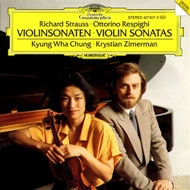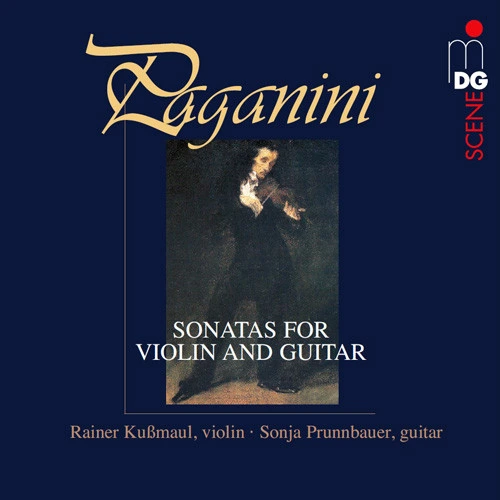180g Audiophile Virgin Vinyl Pressed at Pallas in Germany!
Violinist Kyung-Wha Chung and pianist Krystian Zimerman perform sonatas for violin & piano by composers Richard Strauss and Ottorino Respighi.
Most violin sonatas written after 1880 bear witness to the decline of chamber music as domestic music-making. Both Richard Strauss and Ottorino Respighi treated the solo sonata as a virtuoso genre. The Violin Sonata of Strauss was written in 1887 and represents his last serious essay in abstract chamber msuic before his capitulation to a musical aesthetic derived from Liszt and Wagner. Already in 1886 he had composed a programmatic work for orchestra, Aus Italien, which points towards the tone poem in spite of its four movements. On one sketch for the three-movement Violin Sonata can be found jottings for Macbeth which was to inaugurate the serires of tone poems with which Strauss established himself as a major figure. This can be regarded as a symbolic antithesis of the Brahmsian influence evident in Strauss's early works and of the "progressive" outlook inculcated in him from 1885 by Alexander Ritter.
Whereas abstract instrumental music was a genre in which Strauss lost interest after his earliest works, Ottorino Respighi cultivated it even during the period when he was composing such celebrated orchestral cycles as Fontane di Roma. Respighi was a representative of the Italian generation that attempted to revive Italian instrumental music while Puccini sang the swan song of lyric drama. The arrival of the first modernist generation of Dallapiccola and Petrassi obscured the achievements of Respighi's best-known works, which were often founded on the attempt to restore past glories, whether in the form of Gregorian chant or of the Italian Baroque. At the time of the composition of the Violin Sonata (1917), however, he still looked towards foreign models, including Rimsky-Korsakov, with whom he had studied in St. Petersburg. Among German composers, his model was Wagner; Strauss he seems also to have admired as a composer, though he found him somewhat materialistic as a man. It is tempting to see Respighi's orchestral cycles as the Italian equivalent of the Straussian tone poem; but the composer's wife and biographer, Elsa, tended to dismiss such talk by emphasizing Respighi's Latin fondness for structural clarity. This is particularly evident in the finale of the Violin Sonata, which is a passacaglia in the sense of variations on a ground which migrates form the bass to other parts.
Features:
180g Audiophile Virgin Vinyl
Pressed at Pallas in Germany
From the Original Masters of Universal Music
Audiophile Lacquer Cutting by Maarten de Boer at Emil Berliner Studios
Analogphonic
Import
Musicians:
Kyung-Wha Chung, violin
Krystian Zimerman, piano
Selections:
Side 1:
Richard Strauss (1864 - 1949)
Sonata for Violin and Piano in E flat Major, Op. 18
1. Allegro, Ma Non Troppo
2. Improvisation. Andante Cantabile
3. Finale. Andante-Allegro
Side 2:
Ottorino Respighi (1879 - 1936)
Sonata for Violin and Piano in B minor
1. Moderato
2. Andante Espressivo
3. (Passacaglia). Allegro Moderato Ma Energico
Violinist Kyung-Wha Chung and pianist Krystian Zimerman perform sonatas for violin & piano by composers Richard Strauss and Ottorino Respighi.
Most violin sonatas written after 1880 bear witness to the decline of chamber music as domestic music-making. Both Richard Strauss and Ottorino Respighi treated the solo sonata as a virtuoso genre. The Violin Sonata of Strauss was written in 1887 and represents his last serious essay in abstract chamber msuic before his capitulation to a musical aesthetic derived from Liszt and Wagner. Already in 1886 he had composed a programmatic work for orchestra, Aus Italien, which points towards the tone poem in spite of its four movements. On one sketch for the three-movement Violin Sonata can be found jottings for Macbeth which was to inaugurate the serires of tone poems with which Strauss established himself as a major figure. This can be regarded as a symbolic antithesis of the Brahmsian influence evident in Strauss's early works and of the "progressive" outlook inculcated in him from 1885 by Alexander Ritter.
Whereas abstract instrumental music was a genre in which Strauss lost interest after his earliest works, Ottorino Respighi cultivated it even during the period when he was composing such celebrated orchestral cycles as Fontane di Roma. Respighi was a representative of the Italian generation that attempted to revive Italian instrumental music while Puccini sang the swan song of lyric drama. The arrival of the first modernist generation of Dallapiccola and Petrassi obscured the achievements of Respighi's best-known works, which were often founded on the attempt to restore past glories, whether in the form of Gregorian chant or of the Italian Baroque. At the time of the composition of the Violin Sonata (1917), however, he still looked towards foreign models, including Rimsky-Korsakov, with whom he had studied in St. Petersburg. Among German composers, his model was Wagner; Strauss he seems also to have admired as a composer, though he found him somewhat materialistic as a man. It is tempting to see Respighi's orchestral cycles as the Italian equivalent of the Straussian tone poem; but the composer's wife and biographer, Elsa, tended to dismiss such talk by emphasizing Respighi's Latin fondness for structural clarity. This is particularly evident in the finale of the Violin Sonata, which is a passacaglia in the sense of variations on a ground which migrates form the bass to other parts.
Features:
180g Audiophile Virgin Vinyl
Pressed at Pallas in Germany
From the Original Masters of Universal Music
Audiophile Lacquer Cutting by Maarten de Boer at Emil Berliner Studios
Analogphonic
Import
Musicians:
Kyung-Wha Chung, violin
Krystian Zimerman, piano
Selections:
Side 1:
Richard Strauss (1864 - 1949)
Sonata for Violin and Piano in E flat Major, Op. 18
1. Allegro, Ma Non Troppo
2. Improvisation. Andante Cantabile
3. Finale. Andante-Allegro
Side 2:
Ottorino Respighi (1879 - 1936)
Sonata for Violin and Piano in B minor
1. Moderato
2. Andante Espressivo
3. (Passacaglia). Allegro Moderato Ma Energico



 Turntable Accessories
Turntable Accessories Headphone Accessories
Headphone Accessories Cable Accessories
Cable Accessories Vinyl Accessories
Vinyl Accessories Compact Disc Accessories
Compact Disc Accessories









